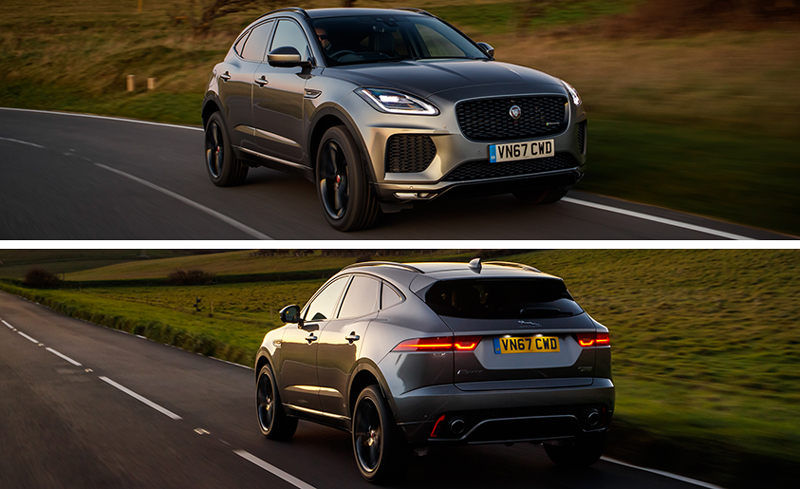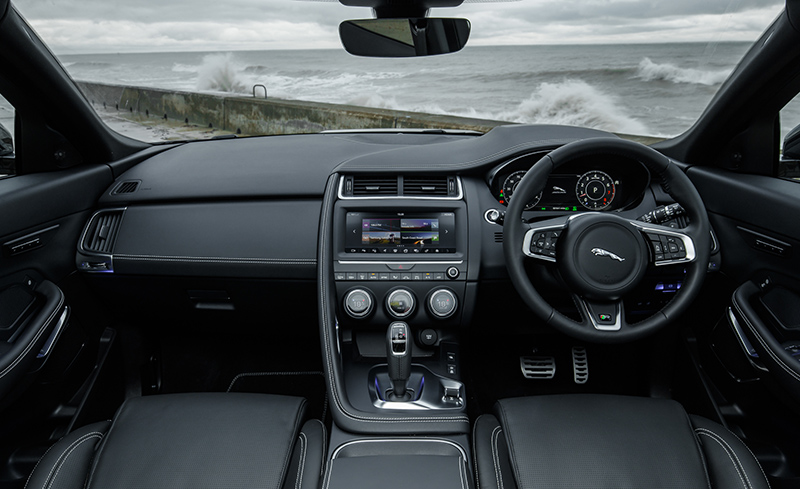2018 Jaguar E-Pace

Although adjacent alphabetically in lists of major automakers, Jaguar and Jeep are polar opposites, but that isn’t keeping Jaguar from following in Jeep’s footsteps. Jeep is a pioneer in minting money with overlapping crossover offerings: Its Renegade, Compass, and Cherokee span less than 16 inches of overall length and are all available with the same 2.4-liter Tigershark four-cylinder, and each somehow pulls its weight on the sales charts without stealing (too many) customers from the others.
As it wades into the crossover arena, Jaguar is taking note. The F-Pace—a name contrived from F as in -type, that super-sexy roadster, and Pace as in . . . well, how much time do you have to delve into some heroically contrived marketing bullshit?—launched just last year, and already it nearly matches the combined sales of every other Jaguar model. So, for its second SUV, Jaguar introduces the E-Pace, which is just over 13 inches shorter and also falls between the Range Rover Evoque and the Land Rover Discovery Sport, which means JLR is out-crowding even Jeep.

The biggest distinction between the F and the E, though, is the latter’s front-drive roots. Like the Evoque on which it’s based, the E-Pace’s chassis consists of struts up front and a multilink rear suspension, with a turbocharged inline-four hitched to ZF’s nine-speed automatic transmission. European markets will get both front-drive and diesel options, but U.S. buyers will choose only between two strengths of gasoline four. There’s standard all-wheel drive or an optional version dubbed Active Driveline that offers selectable front- and all-wheel-drive functions.
Forced Fours
For this first encounter, we were limited to the uprated engine, producing 296 horsepower and 295 lb-ft of torque. With output figures of 246 and 269, the entry-level engine promises to be capable of a fair, uh, pace as well. We’re told the sole difference between the two engines is in how much turbo boost they swallow. But these being members of Jaguar’s new Ingenium engine family, even the higher-output 2.0-liter is far more civilized than the Ford EcoBoost–derived unit that preceded it in the JLR portfolio. It’s vastly more linear at partial throttle, and the nine-speed is calibrated here for quicker, smoother action than we’ve noted in recent encounters with this transmission in Land Rovers. We found few opportunities for full-throttle acceleration on the narrow country lanes between London and Brighton, England, but with nearly 300 horsepower in a 4200-pound wrapper, the E-Pace should have no trouble keeping up with compatriots in the subcompact-luxury segment.

What we appreciated more on the narrow roads threading through pastoral southern England was the E-Pace’s compact footprint and nimble footwork. It rides quite well, even on the 20-inch wheels that were fitted to our example. The wide range of wheel options includes one set of 21s, which might make the E-Pace the smallest and lightest vehicle to offer wheels so big. But on the 20s, there’s no crashing, and even big road disturbances are well damped and isolated. Extensive use of aluminum for suspension components keeps unsprung weight down, no doubt helping the ride stay calm. The steering is quick, linear, and pleasantly light, but we did find the brake pedal a touch too feathery and particularly difficult to modulate at low speeds.
Nice and Tight
The interior design is clean and simple, modern mass-market Jaguar. The front seats are comfortable, but the cabin is positioned so far forward that the passenger will notice the wheel well intruding awkwardly into the footwell. The rear-seat measurements look competitive on paper, but in reality that space is inordinately vertical. Most adult passengers will struggle with kneeroom, even while sitting behind average-size front-seat occupants. Twenty-four cubic feet of cargo space, on the other hand, easily surpasses what most competitors can muster.

Jaguar loyalists who are offended by all these comparisons to Jeep will want to stop reading now. Because where else do you suppose the inspiration might have come from to incorporate the silhouette of a mother jaguar and her cub into the shading at the base of the windshield (which is called frit, for you Scrabble fanatics), much as Jeep has done for years with the profile of a 1941 Willys? The E-Pace’s puddle lamps project the same mother/cub silhouette onto the ground, and in another FCA-esque Easter egg, a jaguar-spot pattern is molded into the stowage-area mats in HSE trims.
Priced by the Pound (per Square Inch)
The E-Pace will reach U.S. dealers early in 2018. Vehicles with the base engine start at $39,595. Those with the 296-hp four will be branded R-Dynamic and start at $48,245, and vehicles purchased in the first year can be configured as First Editions, which pile a bunch of exclusive color and trim options into a fully loaded 246-horse model for $54,545. Jaguar tells us that more than 90 percent of its early orders have come from customers new to the brand, while sales of the F-Pace, as well as the Land Rovers abutting the E-Pace in the lineup, are undiminished. That’s what you call a Jeep thing.
Specifications >
VEHICLE TYPE: front-engine, all- or front-/all-wheel-drive, 5-passenger, 4-door hatchback
BASE PRICES: E-Pace, $39,595;
E-Pace R-Dynamic, $48,245
ENGINE TYPE: turbocharged and intercooled DOHC 16-valve 2.0-liter inline-4, 246 or 296 hp, 269 or 295 lb-ft
TRANSMISSION: 9-speed automatic with manual shifting mode
DIMENSIONS:
Wheelbase: 105.6 in
Length: 173.0 in
Width: 78.1 in Height: 64.9 in
Passenger volume: 95 cu ft
Cargo volume: 24 cu ft
Curb weight (C/D est): 4200 lb
PERFORMANCE (C/D EST):
Zero to 60 mph: 5.9–6.6 sec
Zero to 100 mph: 18.3–19.8 sec
Standing ¼-mile: 14.3–15.2 sec
Top speed: 143–151 mph
EPA FUEL ECONOMY (C/D EST):
Combined/city/highway: 23–24/21–22/27 mpg

 Yahoo Finance
Yahoo Finance 